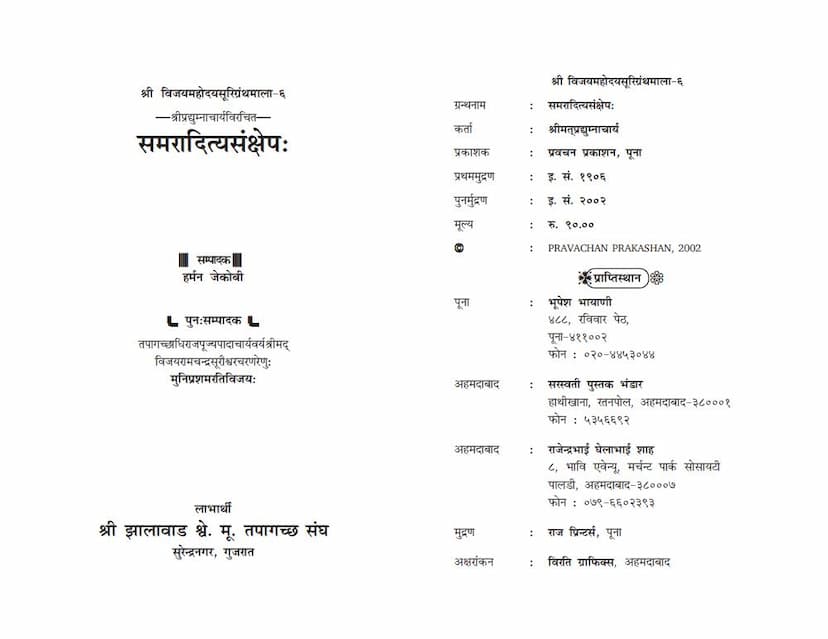Samaraditya Sankshep
Added to library: September 2, 2025

Summary
Based on the provided text, here's a comprehensive summary of the Jain text "Samarāditya Saṅkṣepa":
Book Title: Samarāditya Saṅkṣepa (A concise summary of the Samarāditya epic) Author: Prashamrativijay (attributed as the recommender/guide, with the original work attributed to Prashamrativijay, based on the lineage mentioned in the publisher's note) and Prashamrativijay (as the student of Vijayramachandra Surishwar who supervised the re-publication). The original composition is by Shrimat Pradyumnacharya. Publisher: Pravachan Prakashan Puna Catalog Link: https://jainqq.org/explore/009102/1
Core Theme: The "Samarāditya Saṅkṣepa" is a concise summary of the larger Jain epic "Samarāditya Mahākathā." The central teaching of the epic, and thus this summary, is the renunciation of passions (kashayas) and the pursuit of spiritual liberation. The narrative unfolds over nine lifetimes, illustrating the consequences of actions driven by passions and the eventual path to righteousness.
Origin and Composition:
- The original epic, "Sirimaisamāiścakaha," was composed in Prakrit by the esteemed Acharya Haribhadra Surishwarji Maharaj. Its impact and significance are widely acknowledged.
- The "Samarāditya Saṅkṣepa" is a condensed version of this great narrative, composed in Sanskrit verse by Acharya Shri Pradyumnasurishwarji Maharaj.
- The text was composed in V.S. 1324 (1906 AD), with the re-publication occurring in 2002 AD.
- The first publication was based on manuscripts compiled by Professor Herman Jacobi.
Key Figures and Their Roles:
- Acharya Haribhadra Surishwarji: Author of the original Prakrit epic.
- Acharya Shri Pradyumnasurishwarji: Author of the Sanskrit summary, "Samarāditya Saṅkṣepa."
- Muniprashamrativijay: The disciple of Acharya Shrimad Vijayramachandrasurishwarji Maharaj, who guided the re-publication.
- Acharya Shrimad Vijayhembhushan Surishwarji Maharaj: The inspiration behind the re-publication.
- Shri Zalavad Shvet. Mu. Tapagachh Sangh: The benefactor of the re-publication.
Structure of the Narrative (as indicated by the Table of Contents): The epic, and its summary, follows the nine lifetimes of the protagonist, with each "Bhava" (life) detailing specific events and spiritual lessons. The summary covers:
- First Bhava: Depicts the story of Gunascna and Agnisharma.
- Second Bhava: Focuses on the lives of various characters, highlighting the cycle of birth, death, and the pursuit of dharma.
- Third Bhava: Continues the narrative, illustrating the karmic consequences of actions.
- Fourth Bhava: Further unfolds the complex web of karma and its results through various births.
- Fifth Bhava: Continues to illustrate the journey through different lifetimes.
- Sixth Bhava: Further develops the narrative with more life stories.
- Seventh Bhava: Continues the extensive exploration of cause and effect through different existences.
- Eighth Bhava: Continues to illustrate the journey through different lifetimes, emphasizing the struggle and eventual spiritual progress.
- Ninth Bhava: Culminates the narrative, showing the ultimate liberation of the protagonist.
Central Message and Spiritual Lessons:
- The Power of Karma: The entire narrative emphasizes the law of karma, showing how actions in past lives determine present circumstances.
- Renunciation of Passions: The core teaching is the need to overcome anger, pride, deceit, and greed (kashayas) to achieve spiritual progress.
- The Path to Liberation (Moksha): The ultimate goal is liberation from the cycle of birth and death, achieved through right faith (Samyak Darshan), right knowledge (Samyak Gyan), and right conduct (Samyak Charitra), as outlined in the Jain philosophy.
- The Importance of Spiritual Guidance: The text implicitly highlights the role of spiritual teachers (gurus) in guiding individuals towards the right path.
- The Nature of Existence: The narrative underscores the impermanence of worldly life, wealth, and relationships, urging detachment and the pursuit of eternal spiritual truth.
Publisher's Note: The re-publication is presented as a service for spiritual knowledge ("Jnana Dravya"). A humble request is made for householders not to claim ownership without paying the full amount. The ultimate aspiration is for readers to become inclined towards detachment from worldly existence through study.
Overall: "Samarāditya Saṅkṣepa" is a didactic and inspirational text that uses the compelling narrative of multiple lifetimes to teach the fundamental principles of Jainism, particularly the importance of overcoming passions, understanding karma, and striving for spiritual liberation.